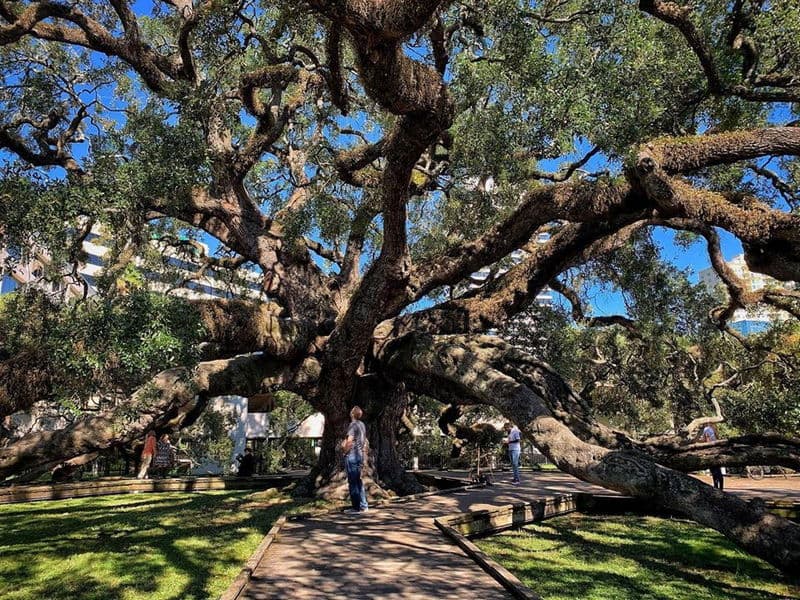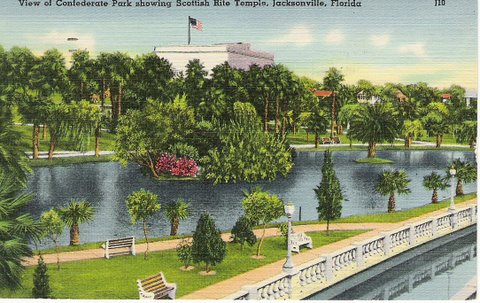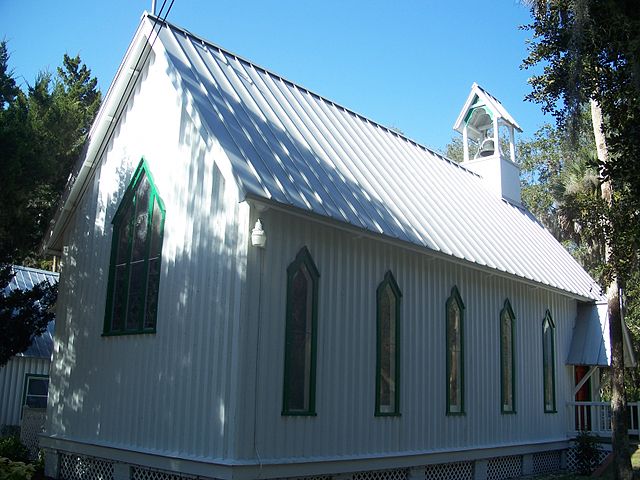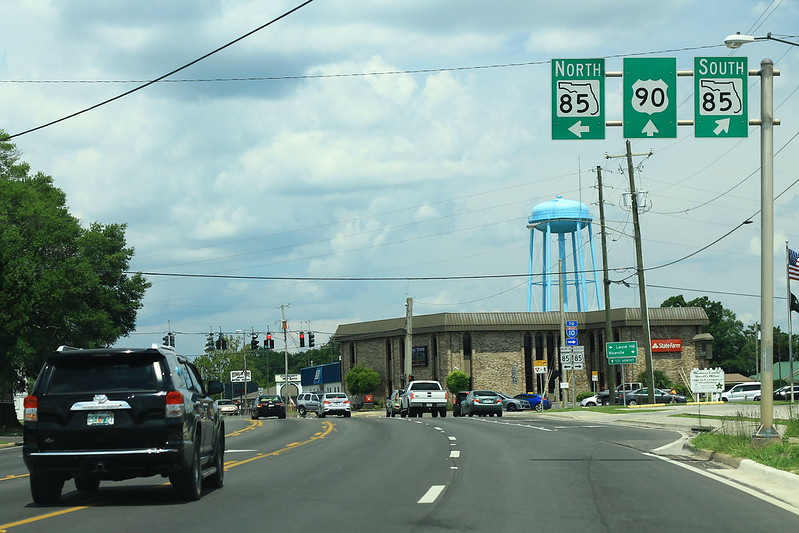- Florida Towns
- Jacksonville
- History of Jacksonville
HISTORY OF JACKSONVILLE, FLORIDA
By Mike Miller Updated May 24, 2022
Jacksonville, Florida has a long history that goes back to the Timucuan Indians who lived in the area along the banks of the St. Johns River 6,000 years ago.
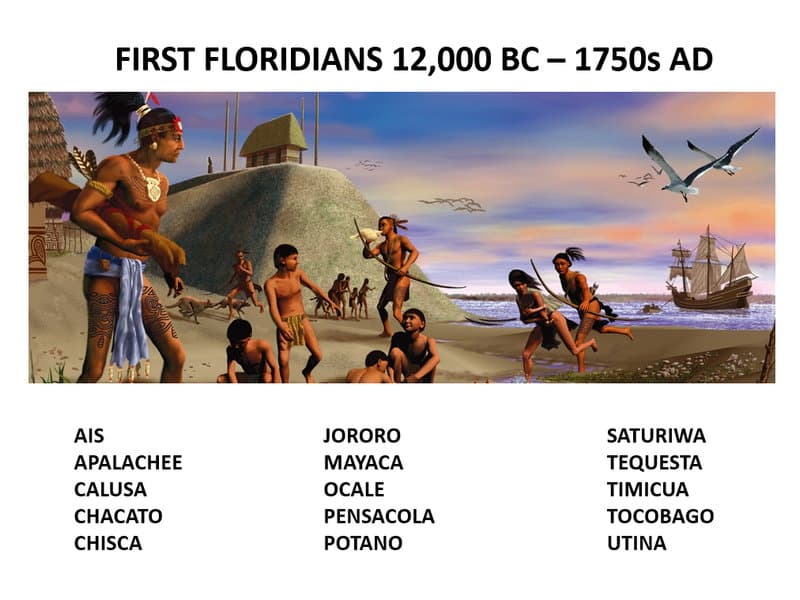
The first Europeans came in 1562. French Huguenot explorer Jean Ribault explored and charted the St. Johns River.
René Goulaine de Laudonnière established the first European settlement at Fort Caroline two years later.
Fort Caroline is about halfway between present day Jacksonville and the Atlantic Ocean.
In 1565, Spanish soldiers from nearby St. Augustine attacked Fort Caroline, and killed nearly all the French soldiers defending it. The Spanish renamed it Fort San Mateo.
After the massacre of the French forces at Fort Caroline, St. Augustine's position as the most important settlement in Florida was solidified.
Treaty Oak in a downtown Jacksonville park has an interesting history that is more modern than many people think. The park was created in a campaign to save the Treaty Oak.
The first settlement near what is now downtown Jacksonville was founded in 1791. It was called Cowford because of its location at a narrow point in the river where cattle once crossed.
In 1822, a year after the United States acquired colonial Florida from Spain, the city was renamed for Andrew Jackson.
Jackson, known as "Old Hickory", was the first military governor of the Florida Territory. He later became President of the United States.
The Jacksonville town charter was approved by the Florida Legislative Council on February 9, 1832. Jacksonville was actually a town in Florida before Florida was a state.
During the American Civil War, Jacksonville was a key supply point for hogs and cattle for the Confederate army.
The city was blockaded by the Union, who gained control of Fort Clinch in Fernandina Beach and most of the surrounding area.
Though no battles were fought in Jacksonville, it changed hands several times, and the city was left in bad shape after the Civil War.
The long memories of southerners included Sherman's march across Georgia and the Union occupation of Jacksonville.
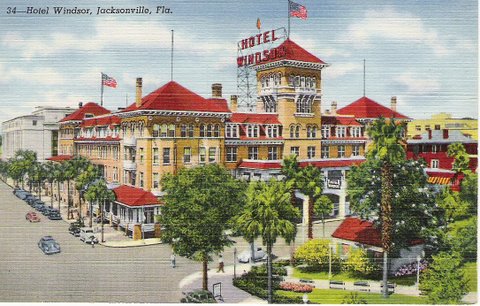
In the years after the Civil War, Jacksonville and St. Augustine became popular winter resorts for the rich and famous. Visitors arrived by steamboat and later by railroad.
President Grover Cleveland attended the Sub-Tropical Exposition in the city on February 22, 1888. His visit increased the reputation of Florida as a place for tourism.
Jacksonville tourism, however, was dealt major blows in the late 19th century by yellow fever outbreaks and the extension of the Florida East Coast Railway to south Florida.
On top of that, Jacksonville was nearly destroyed by "The Great Fire of 1901".
It was one of the worst disasters in Florida history and the largest ever urban fire in the Southeastern United States.
The fire destroyed the business district and made 10,000 residents homeless in the course of eight hours.
The orange glow of the flames could be seen in Savannah, Georgia and the smoke reached Raleigh, North Carolina.
Not many buildings survived the great fire, but the St. George Episcopal Church on Fort George Island still stands as a reminder of Old Florida.
It was far enough away from downtown Jacksonville that the flames never reached it.
The church is an example of Carpenter Gothic Architecture, and was completed in 1883. It is on the U.S. National Register of Historic Places.
The city was completely reconstructed between 1901 and 1912. More than 13,000 new buildings were built during these years.
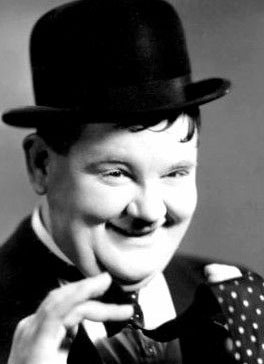
New York-based moviemakers were attracted to Jacksonville's warm climate, exotic locations, excellent rail access, and cheap labor.
In the early 20th century, more than 30 silent film studios were established, earning Jacksonville the title "Winter Film Capital of the World".
Thousands of silent films were made in Jacksonville studios.
Jacksonville's conservative "bible belt" political climate, however, and the emergence of Hollywood as a major film production center ended the city's film industry.
One converted movie studio site, Norman Studios, remains in Arlington; It has been converted to the Jacksonville Silent Film Museum at Norman Studios.
Oliver Hardy, of the famous Laurel and Hardy comedy team, began his career in Jacksonville in 1915.
During the silent movie period (1908-1920), Jacksonville also became a banking and insurance center.
Barnett Bank, Atlantic National Bank, Florida National Bank, Prudential Insurance, Gulf Life Insurance, Afro-American Insurance, Independent Life and American Heritage Life were among the companies based in Jacksonville.
The U.S. Navy also became a major employer and economic force during the 1940s build up to World War Two, with the construction of three naval bases in the city.
Jacksonville, like most large cities in the United States, suffered from negative effects of rapid urban sprawl after World War II.
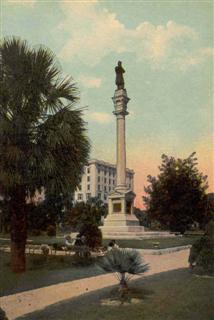
In the mid 1960s, corruption scandals began to arise among many of the city's officials.
These politicians were mainly elected through the traditional "good ole boy" network typical of North Florida in those days.
A grand jury indicted 11 officials and many more were forced to resign.
The concept of consolidating Jacksonville with the rest of Duval County began to gain popular support.
Consolidation was supported by both inner city Blacks, who wanted more involvement in government and suburban whites, who wanted more services and more control over the central city.
The simultaneous loss of accreditation of all fifteen of Duval County's public high schools in 1964 added momentum to the proposals for government reform.
Government was badly broken and needed to be fixed.
Lower taxes, increased economic development, unification of the community, better public spending and effective administration by a more central authority were all cited as reasons for a new consolidated government.
Consolidation took place in 1968, and since then Jacksonville is the largest city in land area in the contiguous United States.
Since most people in Duval County live within the Jacksonville city limits, it is the also the most populous city in Florida and the 12th most populous in the United States.
The Greater Jacksonville Metropolitan Area is home to more than 1.3 million people.
I was in Jacksonville on Confederate Memorial Day, April 26, 1961. In those days, Florida and other southern states did not recognize the "northern" Memorial Day holiday.
The date of the holiday was picked to commemorate the surrender of Confederate General Joseph E. Johnston to Union General William Tecumseh Sherman on April 26, 1865.
I watched the ceremonies take place at Confederate Park in downtown Jacksonville. The sacrifices of long dead southern soldiers were honored.
Although the Civil War had ended nearly a century before, its memories were still very much alive in Jacksonville.
The majority of Jacksonville citizens had been born in south Georgia. Jacksonville was jokingly called "the Capital of South Georgia" by many people.
It still is far more "southern" than any other major Florida city.
LEARN ABOUT JACKSONVILLE, FLORIDA TODAY
Our Facebook page has more than 130,800 followers who love off the beaten path Florida: towns, tourist attractions, maps, lodging, food, festivals, scenic road trips, day trips, history, culture, nostalgia, and more.
By Mike Miller, Copyright 2009-2025
Florida-Back-Roads-Travel.com
Florida Back Roads Travel is not affiliated with or endorsed by Backroads, a California-based tour operator which arranges and conducts travel programs throughout the world.

